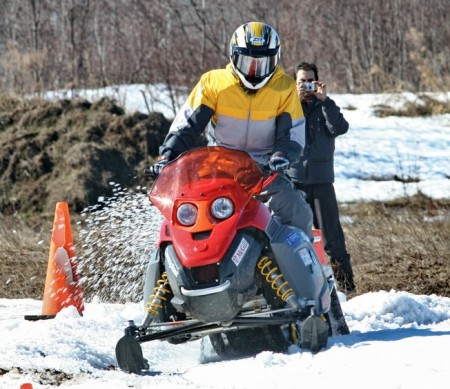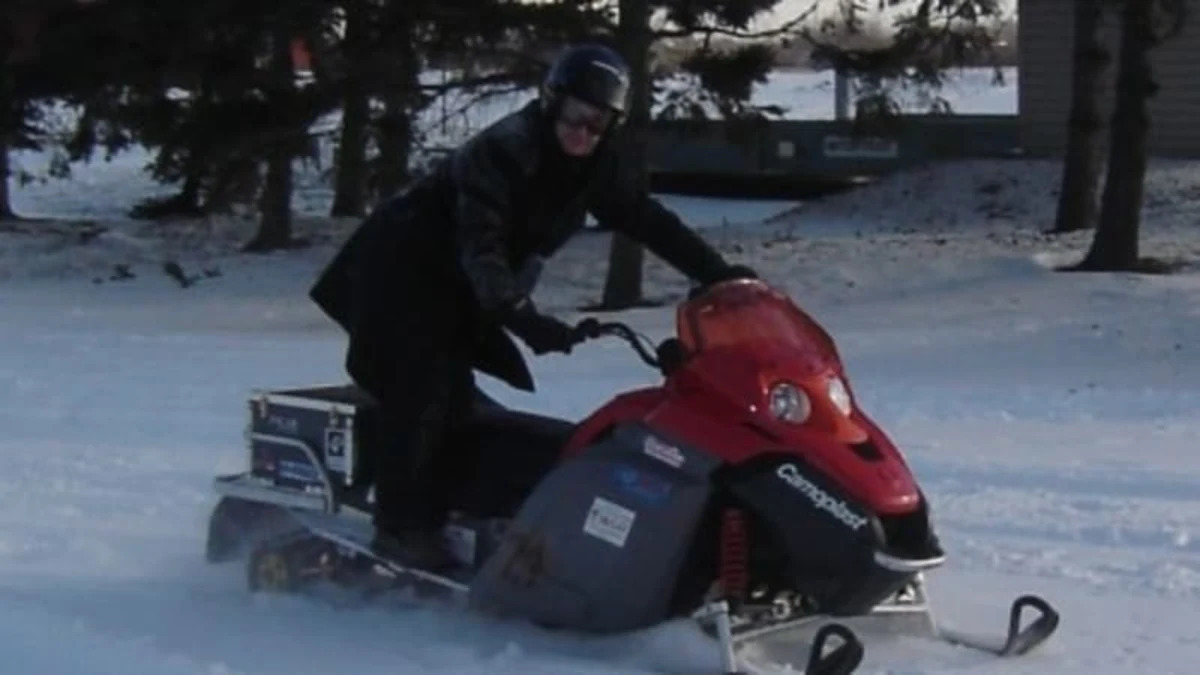click on the photo for a high-res gallery of the McGill electric snowmobile
After our story on the Kettering University Clean Snowmobile Challenger, a member of the team from McGill University in Montreal let ABG know about their own clean snow machine efforts. One of the pioneers and greatest innovators in the early snowmobile industry was Joseph-Armand Bombardier of Valcourt, Quebec, east of Montreal. Bombardier launched the Ski-Doo brand in 1959 and it remains one of the biggest brands to this day.
Given the cold winters in Quebec and proximity to Bombardier, it made sense that when McGill students got into electric vehicles about five years ago they chose to do it by electrifying a snowmobile. McGill was the first team to take a shot at a zero-emission snowmobile with a non-running unit in 2003. Since then they've continually improved the design and demonstrated that a battery-powered snowmobile was possible. No other fully electric teams participated until 2006 and now there is a completely separate category for the electric models.
Continue reading about the McGill electric snowmobile after the jump.
After our story on the Kettering University Clean Snowmobile Challenger, a member of the team from McGill University in Montreal let ABG know about their own clean snow machine efforts. One of the pioneers and greatest innovators in the early snowmobile industry was Joseph-Armand Bombardier of Valcourt, Quebec, east of Montreal. Bombardier launched the Ski-Doo brand in 1959 and it remains one of the biggest brands to this day.
Given the cold winters in Quebec and proximity to Bombardier, it made sense that when McGill students got into electric vehicles about five years ago they chose to do it by electrifying a snowmobile. McGill was the first team to take a shot at a zero-emission snowmobile with a non-running unit in 2003. Since then they've continually improved the design and demonstrated that a battery-powered snowmobile was possible. No other fully electric teams participated until 2006 and now there is a completely separate category for the electric models.
Continue reading about the McGill electric snowmobile after the jump.
[Source: McGill University - Jeff Turner]

The McGill team is currently on their second generation electric snowmobile that debuted in competition in 2006. The current sled is built up from a prototype Ski-Doo Tundra chassis that was donated by Bombardier and was chosen for its light weight. The stock Tundra only weighs 375lbs although the 2006 competition version came in at 520lbs thanks in part to the lithium ion battery pack. Energy storage came by way of a single 72V, 45Ah pack purchased from Lithium Technology Corporation. The single 80lb pack had an integrated controller to manage charging and discharging and 20 series connected cells.
That first pack was mounted at the back of the sled due to its shape and size, which caused some nasty Corvair-like handling behavior. The second generation machine had an on-board 110V charging system so it could be plugged in anywhere and be charged in 3-4 hours. The 520lb weight made it at least 100lbs lighter than any other machine in 2006 regardless of powertrain. Unfortunately the 2006 performance was disappointing due to technical issues with the brushless DC motor that they used and poor support from the supplier.
This year they went back to the drawing board with a new motor and repackaged battery system. The previous single battery pack could really only be mounted behind the seat of the sled. For a snowmobile they generally want more of the weight at the front over the skis. In place of the off the shelf single pack, they created two separate packs with ten cells each that allowed them to be mounted up front with the motor. A compact PMG 132 permanent magnet motor replaced the original unit combined with the now front mounted batteries made for a much more stable machine. All the rework allowed them to also pare another twenty pounds off the weight. By comparison, Clarkson University used NiMH and the South Dakota School of Mines and Utah State created lead acid powered units that weighed in at 850 and 1,000 lbs.
The video meant to be presented here is no longer available. Sorry for the inconvenience.
Check out the McGill electric sled in action
Part of the competition involves the teams preparing reports that include cost estimates for production volumes of at least 5,000 units annually. McGill's battery-powered sled is estimated at $9,000, a $4,000 premium over the standard Ski-Doo Tundra. The downside of battery power is that the range is only about 10-12 miles with a top speed of 30mph. That would work fine for limited applications like getting around a ski area, being the snowbound analog of a neighborhood electric vehicle.
However it would be wholly inadequate for most recreational uses. As a result the crew came up with the winter time equivalent of the Chevy Volt. But more on that in the next article. In the meantime you can check out the results of the 2007 competition including the papers prepared by all the teams at the official Challenge website.


Sign in to post
Please sign in to leave a comment.
Continue